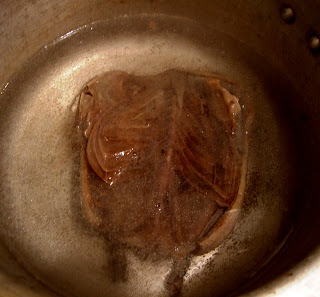Continuing with the Tītī-licious theme, it was time to start cooking. I chose to cook it the old fashioned way as Māori would - boil-up i.e. boiled and served with potatoes, watercress and doughboys. I've always have been the advocate to try dishes first in its original state before you chose to add or create new dishes from it. This not only gives you a better perception of taste but also provides a base for understanding basic flavour concepts.
You start off with putting the tītī (mutton bird) in a pot full of cold water until it covers the bird. Then you cover it and bring it to a boil. A lot of people would say now, as a word of caution to make sure your windows are opened and your hood range on at the highest level as there will be a pungent aroma that will soon fill the room. It is this pungent flavour and the resulting description of the fishy smell that puts off a lot of people from cooking this bird at home. I say, nay. The smell even though pungent, I find to be not any more stronger than when cooking dried fish. So, if you want, feel free to follow the ventilation instructions or just soldier on. As you see the water come to a boil, you will see a lot of fat being rendered out of the bird (photos above). This is because the bird has a high fat layer that insulates it and keeps it warm in the bitter southern cold.
After the water comes to a full rolling boil, you let it remain like that for at least 30-45 mins depending on the number of birds you are cooking. If like me you are cooking just one, then half an hour is enough. The whole reason for the first boil is to render as much fat and salt out of the bird as possible. After 30 mins, you take it off the heat and then drain off all the water along with the rendered fat in it. Personally, I like to keep a bit of the water from this first boil separately and use it later to cook, but more about that later.
After you have drained all the water from the first boil, you add more cold water (same as the first time) and put the pot back on the heat and bring it to another boil for another 30-45 minutes. The second boil is more to cook the bird through and render out any remaining fat out of the bird. This process of changing water after boiling will be dictated by the fat layer on the bird. The more fat the bird has, the more you have to change its water. So just repeat the process.
I drained the water out from the second boil and added fresh water again and put the pot back on the heat to finish cooking the bird. This time, I only added enough water to accommodate the potatoes and watercress and be left with a slight broth to accompany the dish. Personally, I do not like a lot of water in my boil up. I also added potatoes (peeled and halved) along with the bird and let the water come up to a simmer. As the water comes up to a gentle simmer, I add my doughboys. The size and shape of doughboys is a topic of constant debate and your tribal affiliations are often identified by the way you make your doughboys. Flat, small, round, big; I like mine flat (thanks to the King Whānau who introduced me to the world of Maori cuisine and that is how they make theirs). Being flat, it also helps to mop up and remaining broth right at the end.
Usually you would put your water cress or puha before you put your doughboys in. This is to help cook the greens through as most of them come with thick stalks that need a few extra minutes to cook right through. Mine however were just the baby shoots and young leaves so did not require much cooking. So I added them after I put my doughboys in. This is basically the last step to the entire cooking process. You just now let it come to a gentle boil so as to cook the greens out.
By the time the whole thing is done, your potatoes would also be cooked and so would be your doughboys and cress. Note that no where during the cooking process did I add salt. This is because the mutton bird is quite salty due to its curing process and so you don't need to add any extra salt as by the time the bird is served, it is properly seasoned and doesn't need any extra salt.
Voila! The boil up is ready. Mmmmm time to go and eat.









4 comments:
So what do you do with the fat then drain it? this could be fried with bacon or even just a little onion and left to cool, providing a healthy spread for toast could it not? I'm not sure of the flavour my self but you shouldn't waste any part of the bird
Exactly, its too precious to throw away. I fried potatoes once using the fat & tasted good too. Otherwise roasting lamb also works. I sometimes also just spread it a bit on toast with just salt & pepper.
The Mutton Bird Blog is awesome - I showed my brother and he's now on the hunt for a titi. More blogs plz!
Post a Comment